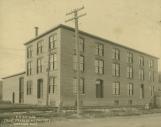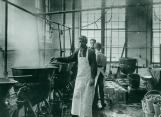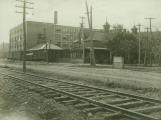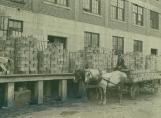1
By 1900 many farmers in the area had purchased thousands of fruit trees from Helderleigh Nursery. E. D. Smith himself also farmed a few acres of fruit trees and plants. The large number of fruit trees being grown resulted in an excess amount of fruit on the market and E.D. Smith decided that the best way to turn the excess fruit into a profit before it spoiled was to make it into jam.2
E. D. Smith's jams were the first pure fruit jams to be made in Canada. Previously most jams sold in Canada were shipped in from England. Jam could be sold for a much higher profit than the fresh produce. These jams were sent by train in five pound green jam pails to small grocery and general stores. The jams were very popular and Mr. Smith decided to set up a production area in the basement of the fruit house. The jam business continued to do well and E.D. Smith decided to build a permanent jam factory that opened in 1905.3
Llewellyn Smith of E. D. Smith Explains how it was a Difficult and Risky Business10 February 2009
E.D. Smith's Jam Factory, E.D. Smith Property, Highway 8, Winona, Ontario, Canada
 Credits:
Credits:Smith, Llewellyn
Grimsby Museum Collection
4
Letter Detailing Construction Dates for E. D. Smith Buildings23 September 1954
E.D. Smith's Jam Factory, E.D. Smith Property, Highway 8, Winona, Ontario, Canada
 Credits:
Credits:Donated by the Niagara Fruit Institute
Grimsby Museum Collection
5
E. D. Smith Jam Factory20th Century, Circa 1905
E.D. Smith's Jam Factory, E.D. Smith Property, Highway 8, Winona, Ontario, Canada
 Credits:
Credits:Donated by the Niagara Fruit Institute
Grimsby Museum Collection
6
Llewellyn Smith of E. D. Smith Describes how Kettle Cooking was Replaced by Continuous Cooking10 February 2009
E.D. Smith's Jam Factory, E.D. Smith Property, Highway 8, Winona, Ontario, Canada
 Credits:
Credits:Smith, Llewellyn
Grimsby Museum Collection
7
Jam Kettles in the E. D. Smith Jam Factory20th Century, Circa 1910
E.D. Smith's Jam Factory, E.D. Smith Property, Highway 8, Winona, Ontario, Canada
 Credits:
Credits:Donated by the Niagara Fruit Institute
Grimsby Museum Collection
8
Filling Jam Cans in the E. D. Smith Jam Factory20th Century, Circa 1910
E.D. Smith's Jam Factory, E.D. Smith Property, Highway 8, Winona, Ontario, Canada
 Credits:
Credits:Donated by the Niagara Fruit Institute
Grimsby Museum Collection
9
In an article of the "Grimsby Independent" in September 1942, the E. D. Smith factory is described."As the E.D. Smith product became better known, the factory could not satisfy the great demand for strawberry jam, which was the key product... From a small beginning the E.D. Smith jam business grew until an amalgamation of several contributors took the leadership away; to today [1942] E.D. Smith's still are possibly the second or third largest jam makers in Canada."
10
E. D. Smith Factory20th Century, Circa 1911
E.D. Smith's Jam Factory, E.D. Smith Property, Highway 8, Winona, Ontario, Canada
 Credits:
Credits:Donated by the Niagara Fruit Institute
Grimsby Museum Collection
11
Farmer Delivering Fruit to the E. D. Smith Jam Factory20th Century, Circa 1914
E.D. Smith's Jam Factory, E.D. Smith Property, Highway 8, Winona, Ontario, Canada
 Credits:
Credits:Donated by the Niagara Fruit Institute
Grimsby Museum Collection
12
The E. D. Smith Jam Factory supported many local growers over the years. With the introduction of Free Trade in the mid 1990's, they could no longer afford to compete with the less expensive American products being brought into Canada. With the development of frozen fruit, E. D. Smith began to receive fruit from around the world. As the fruit did not have to be used immediately this made processing easier with less risk of spoilage. The switch to importing fruit began with strawberries and eventually every fruit used in the jam factory was imported.13
Llewellyn Smith of E. D. Smith Describes how Frozen Fruit Benefitted the Business10 February 2009
E.D. Smith's Jam Factory, E.D. Smith Property, Highway 8, Winona, Ontario, Canada
